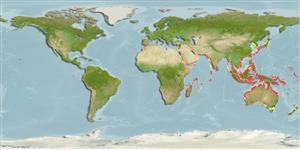Environment: milieu / climate zone / depth range / distribution range
Ekologi
marina; sötvatten; brackvatten; djupintervall 0 - ? m. Tropical
Indo-West Pacific: in western Pacific, known from Thailand, the East Indies, Borneo, and the Philippines north to China and Nagasaki, Japan, south to New Guinea and northern half of Australia.
Length at first maturity / Size / Vikt / Age
Maturity: Lm ?, range 13 - ? cm
Max length : 31.2 cm SL hane/ej könsbestämd; (Ref. 9843)
Taggstrålar i ryggfenan (totalt) : 0; Mjukstrålar i ryggfenan (totalt) : 14 - 17; Taggstrålar i analfenan: 0; Mjukstrålar i analfenan: 13 - 17; Ryggkotor: 51 - 56. Prolonged, beak-like lower jaw, shorter than head length, its length contained in 4.7-8.6 times in SL and 1.2-2.0 times in head length; upper jaw short, scaly, blunt and rounded, its width contained in 0.5-0.6 times in its length; preorbital bone 1.75-2.15 times in diameter of orbit and 0.9-1.15 times in length of upper jaw; preorbital ridge present; posterior branch to preorbital lateral line canal present. Total number of gill rakers on first arch 26-39; dorsal fin rays 14-17, usually 16; anal fin rays 13-17, usually 15 or 16. Caudal fin forked, with lower lobe longer than upper.
Inhabits more turbid and estuarine situations than does Hyporhamphus dussumieri and is not found in oceanic islands (Ref. 9843). May enter rivers (Ref. 559). Found in medium to large-sized rivers of the lower Mekong (Ref. 12975). Occurs in schools (Ref. 3132). Taken mostly with shore seines; marketed mostly fresh and dried salted (Ref. 9843).
Life cycle and mating behavior
Maturities | Reproduktion | Spawnings | Egg(s) | Fecundities | Larver
Collette, B.B. and J. Su, 1986. The halfbeaks (Pisces, Beloniformes, Hemiramphidae) of the Far East. Proc. Acad. Nat. Sci. Philadelphia 138(1):250-301. (Ref. 10943)
IUCN Red List Status (Ref. 130435)
Threat to humans
Harmless
Human uses
Warning: mysqli::__construct(): (HY000/1040): Too many connections in /var/www/html/includes/func_getlabel.php on line 46
Can't connect to MySQL database (fbapp). Errorcode: Too many connections
